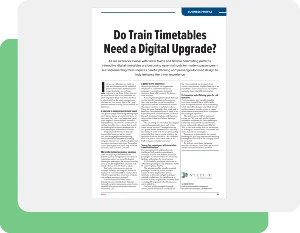How interactive timetables support the new world of train travel
It’s been a while since we cluttered our bookshelves with old fashioned printed timetables. But that doesn’t mean timetables are no longer relevant to our lives. In fact, the way we travel means that train timetables are more important than ever.
There has been a seismic shift in the way passengers use the train service, mostly due to the rising trend for remote working, kickstarted by the pandemic.
A new era in business and leisure travel
The growth of hybrid working means people don’t always have a set pattern in terms of the trains they take – and peak time travel is no longer so clearly defined. Instead of the traditional nine-to-five, commuters are visiting the office two or three days a week, or checking into a remote workspace for a team meeting on a Thursday afternoon.
The post-pandemic rise in domestic tourism has bolstered leisure travel too, and more people are recognising the environmental benefits of avoiding congested motorways and choosing the train to explore our towns and cities.
The upshot is that passengers need more help to decide when and how to travel – not less.
More information for journey planning
With the days of printed timetables behind us, most rail operators have moved timetables online, but even this doesn’t always give passengers the information they need to be able to plan their journeys and decide when is best for them to travel.
That’s why train operators such as Chiltern Railways are using the RailSmart Trainset & Timetables (T&T) solution from Velociti to provide that extra level of clarity that today’s passengers demand.
The introduction of HTML train timetables across the Chiltern Railways network has given passengers access to more detailed information about the routes and trains they take.
A better travel experience
Operating companies can display their timetables in a user-friendly way so passengers can make more informed decisions about which time of the day or week to travel.
A passenger taking the Chiltern Railways service from Birmingham to Leamington Spa could go online to check arrival and departure schedules and see which stations the train is expected to call at and when. Using the same timetable, they could look at how busy their preferred train is likely to be before they book their tickets too, as Martin Howard, Customer Relations and Customer Information Officer at Chiltern Railways explains.
“We are rolling out timetables that display expected occupancy levels of each of the trains on our network. Passengers can see at a glance if their preferred route typically has plenty of seats, or if it’s usually standing room only. This means people who have the option to do so can decide to take a different train at a quieter time, which reduces the load on busier routes for everyone.”
Supporting passengers with accessible travel information
For passengers with additional needs, RailSmart T&T provides timetables in accessible formats and makes it easier for passengers to check whether the necessary facilities will in place for their journey.
“PDF schedules published online can be difficult for passengers with additional needs to access,” explains Martin. “The solution enables visually impaired passengers to use any screen reader to narrate the text displayed on a train timetable so they can navigate a changed schedule or platform. Key details such as whether stations or platforms currently have a working lift or provide wheelchair access can be added too.”
“We have a fully managed timetable service, which means train schedules for the entire network can be drawn from industry systems and displayed exactly as we want them. There’s no need for our staff to manually share timetable information.”
Performance and efficiency gains for rail operators
Train companies gain valuable insights from their timetable data, which can be used to improve services, such as reviewing which timetable changes would help to cut waiting times on popular routes or reduce overcrowding during rush hours to improve the passenger experience.
The system saves Chiltern time and money too. “We now only produce paper timetables on request for those passengers who prefer them, which has saved many hours and considerable cost,” says Martin. “This is time and money that can be invested in making our network more convenient and stress free for our passengers.”
Easy access to information for journey planning will go a long way towards boosting passenger satisfaction in the changing world of rail travel.
Find out more about our passenger-friendly, customised timetables.
See the article in Rail Professional February 2025 issue




